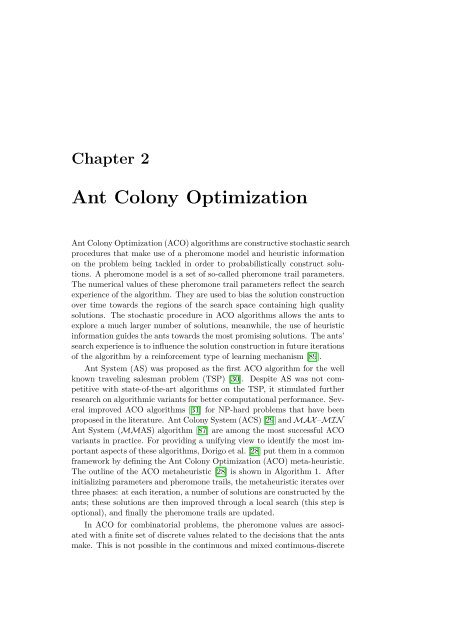Improved ant colony optimization algorithms for continuous ... - CoDE
Improved ant colony optimization algorithms for continuous ... - CoDE
Improved ant colony optimization algorithms for continuous ... - CoDE
Create successful ePaper yourself
Turn your PDF publications into a flip-book with our unique Google optimized e-Paper software.
Chapter 2<br />
Ant Colony Optimization<br />
Ant Colony Optimization (ACO) <strong>algorithms</strong> are constructive stochastic search<br />
procedures that make use of a pheromone model and heuristic in<strong>for</strong>mation<br />
on the problem being tackled in order to probabilistically construct solutions.<br />
A pheromone model is a set of so-called pheromone trail parameters.<br />
The numerical values of these pheromone trail parameters reflect the search<br />
experience of the algorithm. They are used to bias the solution construction<br />
over time towards the regions of the search space containing high quality<br />
solutions. The stochastic procedure in ACO <strong>algorithms</strong> allows the <strong>ant</strong>s to<br />
explore a much larger number of solutions, meanwhile, the use of heuristic<br />
in<strong>for</strong>mation guides the <strong>ant</strong>s towards the most promising solutions. The <strong>ant</strong>s’<br />
search experience is to influence the solution construction in future iterations<br />
of the algorithm by a rein<strong>for</strong>cement type of learning mechanism [89].<br />
Ant System (AS) was proposed as the first ACO algorithm <strong>for</strong> the well<br />
known traveling salesman problem (TSP) [30]. Despite AS was not competitive<br />
with state-of-the-art <strong>algorithms</strong> on the TSP, it stimulated further<br />
research on algorithmic vari<strong>ant</strong>s <strong>for</strong> better computational per<strong>for</strong>mance. Several<br />
improved ACO <strong>algorithms</strong> [31] <strong>for</strong> NP-hard problems that have been<br />
proposed in the literature. Ant Colony System (ACS) [29] and MAX –MIN<br />
Ant System (MMAS) algorithm [87] are among the most successful ACO<br />
vari<strong>ant</strong>s in practice. For providing a unifying view to identify the most import<strong>ant</strong><br />
aspects of these <strong>algorithms</strong>, Dorigo et al. [28] put them in a common<br />
framework by defining the Ant Colony Optimization (ACO) meta-heuristic.<br />
The outline of the ACO metaheuristic [28] is shown in Algorithm 1. After<br />
initializing parameters and pheromone trails, the metaheuristic iterates over<br />
three phases: at each iteration, a number of solutions are constructed by the<br />
<strong>ant</strong>s; these solutions are then improved through a local search (this step is<br />
optional), and finally the pheromone trails are updated.<br />
In ACO <strong>for</strong> combinatorial problems, the pheromone values are associated<br />
with a finite set of discrete values related to the decisions that the <strong>ant</strong>s<br />
make. This is not possible in the <strong>continuous</strong> and mixed <strong>continuous</strong>-discrete

















